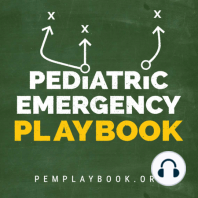47 min listen
The Pediatric Surgical Abdomen
ratings:
Length:
30 minutes
Released:
Aug 1, 2017
Format:
Podcast episode
Description
Abdominal pain is common; so are strongly held myths and legends about what is concerning, and what is not. One of our largest responsibilities in the Emergency Department is sorting out benign from surgical or medical causes of abdominal pain. Morbidity and mortality varies by age and condition. Abdominal Surgical Emergencies in Children: A Relative Timeline General Advice Neonate (birth to one month) Necrotizing Enterocolitis Pneumatosis Intestinalis. Essentials: Typically presents in 1st week of life (case reports to 6 months in chronically ill children) Extend suspicion longer in NICU graduates Up to 10% of all cases of necrotizing enterocolitis are in full-term children Pathophysiology is unknown, but likely a translocation of bacteria Diagnosis: Feeding intolerance, abdominal distention Abdominal XR: pneumatosis intestinalis Management: IV access, NG tube, broad-spectrum antibiotics, surgery consult, ICU admission Intestinal Malrotation with Volvulus Essentials: Corkscrew Sign in Malrotation with Volvulus Bilious vomiting (80-100%) in the 1st month; especially in the 1st week May look well initially, then rapidly present in shock Ladd’s bands: abnormally high tethering of cecum to abdominal wall; peristalsis, volvulus, ischemia Diagnosis: History of bilious emesis is sufficient to involve surgeons Upper GI series: corkscrew appearance US (if ordered) may show abnormal orientation of and/or flow to superior mesenteric artery and vein Management: Stat surgical consult IV access, resuscitation, NG tube to decompress (bowel wall perfusion at risk, distention worsens) Hirschprung Disease Essentials: Problem in migration of neural crest cells Aganglionic colon (80% rectosigmoid; 15-20% proximal to sigmoid; 5% total colonic aganglionosis) colon (known as short-segment disease) Poor to no peristalsis: constipation, perforation, and/or sepsis Diagnosis: May be diagnosed early as “failure to pass meconium in 1st 48 hours” In ED, presents as either bowel obstruction or enterocolitis Contrast enema Beware of the toxic megacolon (vomiting, distention, sepsis) Management: Resuscitation, antibiotics, NG tube decompression, surgical consultation; stable patients may need rectal biopsy for confirmation Staged surgery (abdominoperineal pull-through with diverting colostomy, subsequent anastomosis) versus one-stage repair. Infant and Toddler (1 month to 2 years) Pyloric Stenosis Essentials: Hypertrophy of pyloric sphincter; genetic, environmental, exposure factorsString Sign in Pyloric Stenosis. Diagnosis: Hungry, hungry, not-so-hippos; they want to eat all of the time, but cannot keep things down Poor weight gain (less than 20-30 g/day) US: “π–loric stenosis” (3.14); pylorus dimensions > 3 mm x 14 mm UGI: “string sign” Management: Trial of medical treatment with oral atropine via NGT (muscarinic effects decrease pyloric tone) Ramstedt pyloromyotomy (definitive) Intussusception Essentials: Majority (90%) ileocolic; no pathological lead point Small minority (4%) ileoileocolic due to lead point: Meckel’s diverticulum, polyp, Peyer’s patches, Henoch-Schönlein purpura (intestinal hematoma) Diagnosis: Target Sign (Donut Sign). Ultrasound sensitivity and specificity near 100% in experienced hands Abdominal XR may show non-specific signs; used mainly to screen for perforation before reduction Management: Hydrostatic enema: contrast (barium or water-soluble contrast with fluoroscopy) or saline (with ultrasound) Air-contrast enema: air or carbon dioxide (with either fluoroscopy or ultrasound); higher risk for perforation than hydrostatic (1% risk), but generally safer than perforation from contrast Consider involving surgical service early (precaution before reduction) Traditional disposition is admission; controversial: home discharge from ED Young Child and Older (2 years and up) Appendicitis Essentials: Appendicitis occurs in all ages, but rarer in infants. Infants do not have fecalith
Released:
Aug 1, 2017
Format:
Podcast episode
Titles in the series (100)
Foreign Bodies in the Head and Neck: Children the world over are fascinated with what can possibly “fit” in their orifices. Diagnosis is often delayed. Anxiety abounds before and during evaluation and management. Most common objects:1,2 Food Coins Toys ... by Pediatric Emergency Playbook
